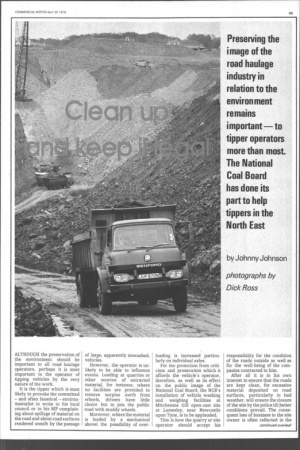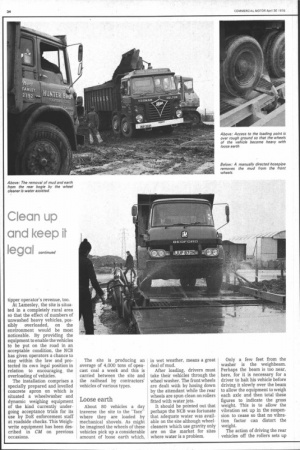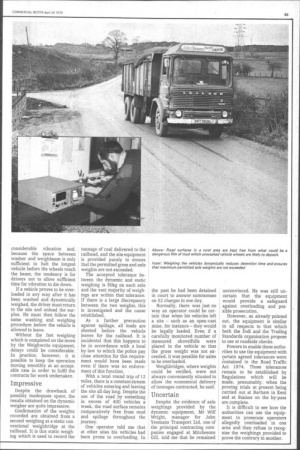photographs by Dick Ross by Johnny Johnson
Page 35

Page 36

Page 37

If you've noticed an error in this article please click here to report it so we can fix it.
ALTHOUGH the preservation of the environment should be important to all road haulage operators, perhaps it is most important to the operator of tipping vehicles by the very nature of the work.
It is the tipper which is most likely to provoke the committed — and often fanatical — environmentalist to write to his local council or to his MP complaining about spillage of material on the road and about road surfaces rendered unsafe by the passage of large, apparently unwashed, vehicles.
However, the operator is unlikely to be able to influence events. Loading at quarries or other sources of extracted material, for instance, where no facilities are provided to remove surplus earth from wheels, drivers have little choice but to join the public road with muddy wheels.
Moreover, where the material is loaded by a mechanical shovel the possibility of over loading is increased particularly on individual axles.
For the protection from criticism and prosecution which it affords the vehicle's operator, therefore, as well as its effect on the public image of the National Coal Board, the NCB's installation of vehicle washing and weighing facilities at Mitchesons Gill open-cast site at Lamesley, near Newcastle upon Tyne, is to be applauded.
This is how the quarry or site operator should accept his responsibility for the condition of the roads outside as well as for the well-being of the companies contracted to him.
After all it is in his own interest to ensure that the roads are kept clean, for excessive material deposited on road surfaces, particularly in bad weather, will ensure the closure of the site by the police till better conditions prevail. The consequent loss of business to the site owner is often reflected in the tipper operator's revenue, too.
At Lamesley, the site is situated in a completely rural area so that the effect of numbers of unwashed heavy vehicles, possibly overloaded, on the environment would be most noticeable. By providing the equipment to enable the vehicles to be put on the road in an acceptable condition, the NCB has given operators a chance to stay within the law and protected its own legal position in relation to encouraging, the overloading of vehicles.
The installation comprises a specially prepared and levelled concrete apron on which is situated a wheelwasher and dynamic weighing equipment of the kind currently undergoing acceptance trials for its use by DoE enforcement staff at roadside checks. This Weighwrite equipment has been described in CM on previous occasions. The site is producing an average of 4,000 tons of opencast coal a week and this is carried between the site and the railhead by contractors' vehicles of various types.
Loose earth
About 80 vehicles a day traverse the site to the "face" where they are loaded by mechanical shovels. As might be imagined the wheels of these vehicles pick up a considerable amount of loose earth which, in wet weather, means a great deal of mud.
After loading, drivers must take their vehicles through the wheel washer. The front wheels are dealt with by hosing down by the attendant while the rear wheels are spun clean on rollers fitted with water jets.
It should be pointed out that perhaps the NCB was fortunate that adequate water was available on the site although wheelcleaners which use gravity only are on the market for sites where water is a problem. Only a few feet from the washer is the weighbeam. Perhaps the beam is too near, here, for it is necessary for a driver to halt his vehicle before driving it slowly over the beam to allow the equipment to weigh each axle and then total these figures to indicate the gross weight. This is to allow the vibration set up in the suspension to cease so that no vibration factor can distort the weight.
The action of driving the rear vehicles off the rollers sets up considerable vibration and, because the space between washer and weighbeam is only sufficient to halt the longest vehicle before the wheels reach the beam, the tendency is for drivers not to allow sufficient time for vibration to die down.
If a vehicle proves to be overloaded in any way after it has been washed and dynamically weighed, the driver must return to the site and unload the surplus. He must then follow the same washing and weighing procedure before the vehicle is allowed to leave.
Without the fast weighing which is completed on the move by the Weighwrite equipment, delays could be considerable. In practice, however, it is possible to keep the operation moving smoothly at an acceptable rate in order to fulfil the contracts for work undertaken.
Impressive
Despite the drawback of possibly inadequate space, the results obtained on the dynamic weigher are quite impressive.
Confirmation of the weights recorded are obtained from a second weighing at a static conventional weighbridge at the railhead. It is this static weighing which is used to record the tonnage of coal delivered to the railhead, and the site equipment is provided purely to ensure that the permitted gross and axle weights are not exceeded.
The accepted tolerance between the dynamic and static weighing is 50kg on each axle and the vast majority of weighings are within that tolerance. If there is a large discrepancy between the two weights, this is investigated and the cause established.
As a further precaution against spillage, all loads are sheeted before the vehicle leaves for the railhead. It is incidental that this happens to be in accordance with a local by-law to which the police pay close attention for this requirement would have been made even if there was no enforcement of this function. • With a total round trip of 12 miles, there is a constant stream of vehicles entering and leaving the site all day long. Despite the use of the road by something in excess of 400 vehicles a week, the road surface remains comparatively free from mud and spillage throughout the journey.
One operator told me that at other sites his vehicles had been prone to overloading. In the past he had been detained in court to answer summonses on 52 charges in one day.
Normally, there was just no way an operator could be certain that when his vehicles left a site — such as an open-cast mine, for instance — they would be legally loaded. Even if a carefully monitored number of measured shovelfulls were placed in the vehicle so that the gross weight was not exceeded, it was possible for axles to be overloaded.
Weighbridges, where weights could be verified, were not always conveniently situated to allow the economical delivery of tonnages contracted, he said.
Uncertain
Despite the evidence of axle weighings provided by the dynamic equipment, Mr Wilf Wright, manager for John Yeomans Transport Ltd, one of the principal contracting companies engaged at Mitchesons Gill, told me that he remained unconvinced. He was still uncertain that the equipment would provide a safeguard against overloading and possible prosecution.
However, as already pointed out, the equipment is similar in all respects to that which both the DoE and the Trading Standards organisation propose to use at roadside checks.
Powers to enable these authorities to use the equipment with certain agreed tolerances were Contained in the Road Traffic Act 1974. Those tolerances remain to be established by Regulations which will be made, presumably, when the proving trials at present being carried out at Barham in Kent and at Staines on the by-pass are complete, It is difficult to see how the authorities can use the equipment to prosecute operators allegedly overloaded in one area and then refuse to recognise the weighings provided to prove the contrary in another.
















































































































































